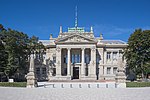Strasbourg tramway

The Strasbourg tramway (French: Tramway de Strasbourg, German: Straßenbahn Straßburg; Alsatian: D'Strossabàhn Strossburi(g)), run by the CTS, is a network of six tramlines, A, B, C, D, E and F that operate in the cities of Strasbourg in Alsace, France, and Kehl in Baden-Württemberg, Germany. It is one of the few tram networks to cross an international border, along with the trams of Basel and Geneva. The first tramline in Strasbourg, which was originally horse-drawn, opened in 1878. After 1894, when an electric-powered tram system was introduced, a widespread network of tramways was built, including several longer-distance lines on both sides of the Rhine. Use of the system declined from the 1930s onwards, and the service closed in 1960 in parallel with many other tramways at the time. However, a strategic reconsideration of the city's public transport requirements led to the reconstruction of the system, a development whose success led to other large French cities reopening their tramways, such as Montpellier and Nice. Lines A and D were opened in 1994, lines B and C were opened in 2000, line E was opened in 2007 and line F was opened in 2010. It is regarded as a remarkable example of the tramway's rebirth in the 1990s. Together with the success seen in Nantes since 1985, the Strasbourg experiment resulted in the construction of tramways in multiple other French urban areas, and the expansion of tramway systems remains an ongoing project in Strasbourg and throughout France. Since 2017, the tram system also reaches Kehl on the right bank of the Rhine, in Germany. While the prior tram network also included such a Rhine-crossing line at times, this section of the Rhine did not form the border between France and Germany from 1871 to the end of World War I and during World War II when Alsace (including Strasbourg) was annexed to Germany.
Excerpt from the Wikipedia article Strasbourg tramway (License: CC BY-SA 3.0, Authors, Images).Strasbourg tramway
Rue du Marché-Gare, Strasbourg Cronenbourg
Geographical coordinates (GPS) Address Nearby Places Show on map
Geographical coordinates (GPS)
| Latitude | Longitude |
|---|---|
| N 48.594166666667 ° | E 7.7358333333333 ° |
Address
Ligne Dépôt
Rue du Marché-Gare
67083 Strasbourg, Cronenbourg
Grand Est, France
Open on Google Maps








